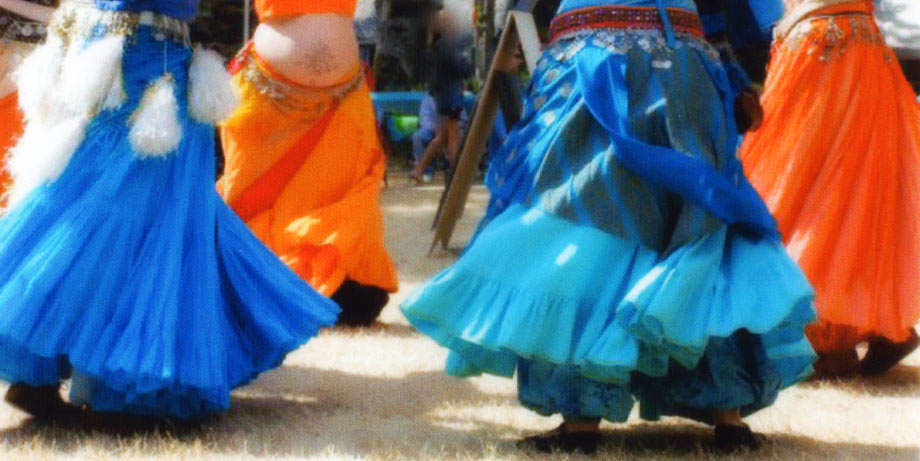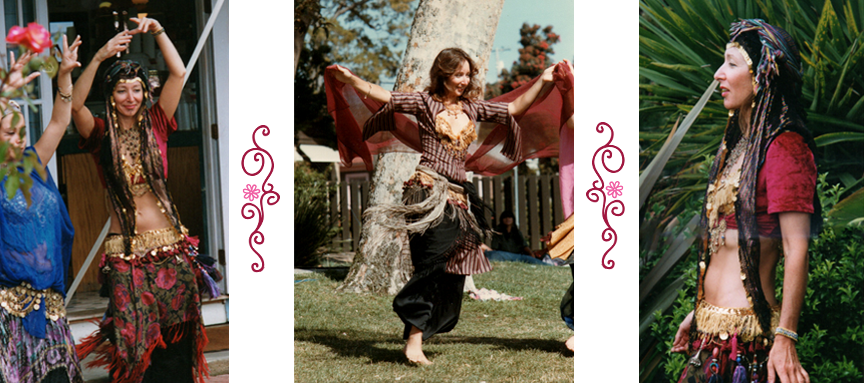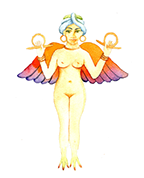

Belly Dancing as an Invocation of Shakti
by Barbara Beausoleil
An excerpt from FEMININE MYSTICISM IN ART: ARTISTS ENVISIONING THE DIVINE - Edited by Victoria Christian and Susan Stedman
When I started my dance troupe, Raks Sarama, in 2002, I had been a student of Tantra for many years. I had also been doing tribal style Middle Eastern dance for over a decade. The two blended well together, as if they were soul partners. The undulating movements of what most of us know as belly-dancing are sensual and life-affirming. In tribal style dance, we rarely dance alone. I describe what we do to be a cross between belly-dance and folk dance. We dance in a group, sometimes with a dozen or more dancers moving in unison, creating waves in the space that surrounds us. It is like making love to the air. In our finest moments, the dance becomes a prayer, an invocation of Shakti. For me, this dance is the embodiment of female power and feminine mysticism. All bodily movement generates air currents, waves of air that undulate outward into the Universe. When many dancers move in unison, the wave that is created is larger and moves farther. I have even seen balls of light generated by a group of dancers; such is the ability of the group to focus their energy.
Some people call us belly-dancers, but this is a deceptive term, one that brings to mind a scantily clad woman shimmying and gyrating across the floor. Our dances are based on Middle Eastern movements and rhythms, but we draw from many other disciplines as well, from ballet and flamenco, to Native American and Polynesian. We are fusion folk dancers. We dance at festivals and fairs, weddings, parties and proms. We dance for the sheer joy of it, for the pleasure of moving our bodies through the air to the rhythm of the drums, and because it is a sacred Tantric ritual, one that joins us at the hip and the heart. We begin our ritual with a hot bath, preferably in a deep claw-foot tub. After the bath, the dancer starts assembling the multiple layers of her costume. We start with harem pants. Since these are closest to the skin, the kind of fabric they are made of is very important. It must be soft and fairly light, not too heavy, stiff or scratchy. It must feel good against your skin. I prefer cotton or silk. The color will depend on the rest of the costume. I have a dozen pairs of harem pants to choose from, in a myriad of colors. Getting dressed is like turning yourself into a piece of art- a colorful sculpture that moves. A full circle kirt goes over the harem pants. The fabric must have some weight to it so that it flares out as the dancer spins, exposing the billowing harem pants beneath.

READ MORE
Copyright 2011 by Victoria Christian. All right reserved. No part of the book may be used or reproduced in any manner whatsoever without written permission except in the case of brief quotations embodied in critical articles and reviews. For information, please contact New Paradigm Publishing, www.victoriachristian.com.
Raks Sarama Playlist



©2014 Beth Hall | Images are copyrighted to their respective owners
< BACK TO HOME